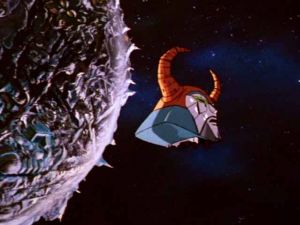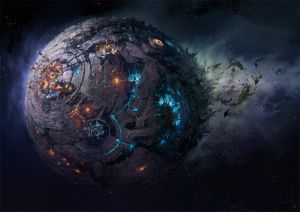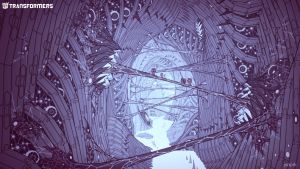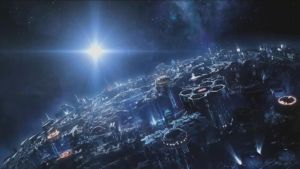The Religion of the Transformers
By Hervé St-Louis
January 5, 2013 - 13:52
 |
In recent years, Hasbro seemed to have mandated that the cultural myths developed around the Transformers be more systematic. Unicron, the Creation Matrix, the Key to Vector Sigma are all religious props that in the first generation of Transformers’ cartoons was used mostly as ex deus machina, or the gadget of the week that writers used to find an excuse to pit factions of Autobots against factions of Decepticons. Other Hasbro franchises, like G.I. Joe followed a similar formula where they would fetch throughout the world strange technological artifacts as if involved in an arms race to find against one another. In fact, whoever held the most “magical” artifact won the battle.
While in G.I. Joe’s universe, the artifact provided the winning faction with an edge against its opponent, they were often scientifically-based. They were natural resources, or technologies lost. The Transformers had similar quests in their first stories in the 1980s Marvel Studio cartoon series. Mostly, the Transformers were in a constant fight to appropriate for themselves energy resources needed to remain alive and revive their dead planet Cybertron.
However, the concept of life took on a more exotic and complex form in both the Transformers’ cartoon series and the comic book published by Marvel Comics. The Autobots and the Decepticons easily added troops to their team by simply constructing new robots out of Earthly materials. Hence, the Autobots created the Dinobots and the Decepticons spent weeks, as quoted by Megatron creating the Constructicons on Earth. The ease with which these new robots could be created meant that there had no real souls or sparks to populate their bodies. Hence, any Transformers could simply be rebuilt.
 |
And so when the time came to introduce a new faction of Autobots and Decepticons in the second season of the Transformers, the Vector Sigma was used as the prop that gave the Aerialbots and the Stunticons their lives. To create the Combaticons a few episodes later, Starscream had to rely on imprisoned minds of Decepticon convicts.
By the time the Transfomers first animated movie came around, the concept of life and death, which is central to many religions came at the forefront forcefully with the death of several Autobots and Decepticons while faith in the magical artifact called the Matrix of Leadership was essential to the ordaining of a new Autobot leader, in a papal role making him the bearer and representative of a greater spiritual force in the concrete world that had enough power to take on the Unicron a transforming planet similar to Marvel Comics’s Galactus that also had to power to grant life to Transformers, such as Cyclonus, Scourge and his Sweeps. Two god-like forces confronted each other resulting in the destruction of one of them.
Unicron’s lore was further expanded and this time confronted with Primus, his equal opponent. Each were forces beyond the mechanical shell of the Transformers that gave themselves physical bodies and created life out of mechanical devices instead of flesh. These lives were embedded with sparks which were much like souls. If a spark died, the body of a Transformer would die. That is, unless it was Starscream, whose sparks was like a ghost and could possess other Transformers.
 |
I think that the obsession for explaining the origins of the Transformers through a religious perspective happens because they are a different form of life that defies the biological determinism and evolution theories for life on Earth. But unlike other android-like forms of life in other popular culture, such as the Red Tornado and the Vision of the Justice League and the Avengers, the Transformers originate not from Earth, like Isaac Asimov’s robots, but from another plane of existence. Astro Boy does not have a soul, but advanced technology gave him one. However, Astro Boy, like the Vision and the Red Tornado were built through human intellect and are therefore children of humans. They can have a soul only if gained through evolution, much like Pinocchio. Notice that the Quintessons, the so-called creators of the Transformers as explained in the third season of the cartoon series were quickly brushed aside in favour of the Unicron creation myth. The Transformers as puppets did not resonate well, it would seem.
Moreover, the Transformers’ planet, Cybertron is of the same nature as the Transformers. It is a technology. Its design suggests that it has always been technology in structure. As such, life on Cybertron is a construct of advanced design. Decepticons seem to often be on the shorter end of the religious spectrum in that they have very few artifacts of their own and except for Unicron, nothing to back up their faith system against the Autobots’. In fact, when confronted with their ignorance of specific Autobot religious lore, Decepticons often don’t tend to challenge these beliefs at all. They seem to embrace them even if they have to play the devilish antagonists of the belief system. Often, Decepticons cannot wield or gain powers from Autobot relics. In a sense, the religion of the Autobots does not afford a sense of universalism unless a Decepticon is willing to become an Autobot and renege his own culture. It is not a full exclusion of the other but a way to salvation, much like Christianity. A Decepticon in high regards who forgoes the dogma of his religion becomes a fallen, much like Megatronus, one of the original 13 Primes (he was the Judas of the bunch).
 |
But as with any religion, there are taboos in the Transformers' faith. The main one is the concept of sex and reproduction. As the Transformers became more and more human in their depiction, they also gained the concept of gender. Transformers of different gender have been shown to have mutual feelings similar to love for one another. But the issue of sex has not been breached in the Transformers’ lore mainly to protect Hasbro from vindictive parents. Thus the reproduction of Transformers through sexual means has not been explored and instead, the super natural means for which life is given to a Transformer has been the preferred explanation except in the last Transformers’ live action film where the concept of hatchlings was introduced but never fully explained in terms of reproduction. Instead, more magical artifacts were elevated in the storyline. This, of course, shows a consistent taboo in the world of the Transformers, akin to the taboos of established religion outside of the world of fiction.
Related Articles:
Transformers: Rise of the Beasts
Bluefin Announces New Flame Toys Transformers Model Kits
VIZ Media Announces "Transformers: A Visual History"
Bluefin Announces New Transformers Die Cast and Model Kit
Bluefin Offers Transformers Optimus Prime Furai Model Kit
Bluefin Selling "Tarn" Transformers Action Figure
Bluefin Announces Transformers "Drift" Figure
Transformers: The Last Knight
The Transformers as Transgender?
Binquirer May 16 204 - New Transformers Movie News and Kitty Kat Web Comic
